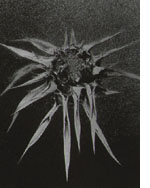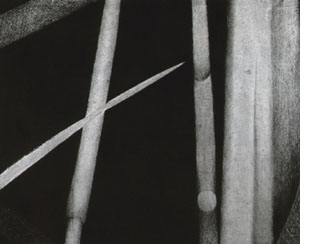
Spring
1998
Iconoclasm revisited
![]()
![]()
Soundings is a publication of the School of Humanities and Social Science at MIT
Comments and questions to www-shss@mit.edu
Hidden gems:
artist behind the desk
Pass the surreal,
please
 |
|
Thistle: |
On rare occasions Janet Sahlstrom considered attending art school. But such wayward thoughts were few and fleeting. "I didn't like what I saw. A lot of the students' paintings looked like the teachers' paintings," explains the administrative officer of the Political Science Department. "If people are going to evaluate my work based on whether it looks like theirs, I'm not going to participate."
Holding quietly to the maxim that visual art is about individual expression, Sahlstrom has steadfastly practiced her métier for the past quarter century, showing her work in scores of both group and solo exhibitions. Hop scotching her way through various promotions and MIT departments along the way — including the Physics Department and Media Lab — the self-taught artist has considerably transformed her style in the interim.
Two decades ago Sahlstrom's work took a representative form — charcoals of the natural world, focusing on landscapes and close ups of landscape elements such as branches and leaves. Then she had a pivotal moment. When her son, now 17-years-old, was an infant, she was out taking him for a walk. "He was looking up at the play of sunlight in the trees. It was a total visual experience for him, absolutely direct," she recalls. "I realized he had no mental constructs, no language, to define what he was experiencing." That revelation became a milestone that furthered her transition to the surreal. She created The Owl and the Pussycat, a landscape fashioned from objects not conventionally used for landscapes, including fabric and a drawing of a Balinese carving. "It clarified for me T.S. Eliot's expression in The Four Quartets about coming to a place you've known before but seeing it for the first time. In watching my son, I realized how our way of interpreting the world, our constructs, remove us from reality at the same time we use these constructs to define reality. This surreal composition was a way to take familiar objects and rearrange them to make us look again and perhaps see them for the first time or in a new way."

Grass
Blades:
charcoal on rice paper, 20" x 26"
These days, Sahlstrom is experimenting in a different way with perspective, size, dimension, and the relocation of objects. Exploring the notion of frames and how composition influences what the eye does, she is focusing on small watercolors of fruits. In a recent work, she painted an apple bursting beyond the frame. In another — whose effect is quasi-trompe-l'oeil — she drew a frame within the frame and had a mango propel beyond the inner border, as if coming out of the picture. "I have no idea where I'm going with it, but I'm having fun," says Sahlstrom, musing that with the pending departure of her son to college, perhaps these recent experiments with framing are about "an empty nest and ‘changing the frame.' Maybe that's why I wouldn't go to art school and have someone dictate how to paint. For me, art is a process of self-discovery. How can someone else tell me what that self is?"
Artistic flair often resides in the most unexpected places. In our Artists Behind the Desk series, we profile the unsung artistry - visual arts, dance, music, theater, and poetry - found amidst the 480 faculty and staff of the School of Humanities and Social Science.
Copyright © 2000 Massachusetts Institute of Technology